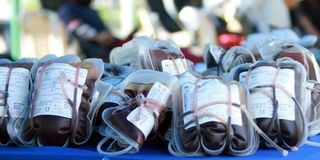How Facebook is using AI to boost blood donation

Kenyans donate blood at KICC on June 12 ahead of World Blood Donor Day.
The Blood Donations feature on Facebook has an option to sign up as a donor where users who opt in have the choice to indicate their willingness to donate blood in the Facebook app.
If trusted blood donation centres at the KNBTS need to find donors, they can create special page posts that inform donors what they need and include a call to action button that allows donors to contact them directly.
Once a blood donor request is posted, people located nearby who have indicated their willingness to donate blood will be notified of the request through their Facebook notifications. To achieve this, Facebook uses AI and geo-location data.
Notified donors are able to review a given request and contact the person requesting blood if they wish to respond to it.
Since the launch of Facebook's blood donation tool in 2017, more than 70 million people have signed up to be blood donors.
The feature is currently available in South Africa, the US, Brazil, Bangladesh, India and Pakistan and in June, it was launched in Kenya, Senegal, Egypt, Burkina Faso and Côte d'Ivoire.
But, Facebook's journey to use AI in blood donation has not been smooth. It took its engineers two years of research and development to create the perfect ML model.
Many countries have too few blood donors to provide everyone with reliable access to safe blood, per data from the World Health Organization. "Since people were already coming to Facebook to address this need, we wanted to use AI to help communities do it faster and more effectively," says a statement from Facebook engineers.
POTENTIAL DONOR
ML, in particular, excels at distinguishing a Facebook post that references a need for blood donors.
With an effective AI system, someone who posted a Facebook message about the importance of giving blood could be given information about how to register as a potential donor and then could choose to be notified whenever there was an urgent need nearby.
For this feature, Facebook engineers were faced with an obstacle from the very beginning: ML systems need to be trained with relevant examples, but those examples were scarce in this case in 2017.
AI models have no innate powers of learning and self-improvement like humans, and most train on only the information they are given, which has to be as specific and as purpose-oriented as possible. AI does what it is trained to do and, in the case of blood donation-related content, there were not enough useful examples.


